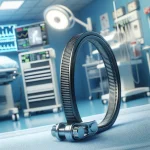Cable ties, those small yet mighty tools, have found their way into the medical field, proving their versatility beyond the usual bundling of wires and cables. In healthcare, precision and safety are paramount, and cable ties offer both, along with the convenience that medical professionals rely on. This blog post delves into the various applications of cable ties in medicine, showcasing their importance and the innovative ways they contribute to healthcare.
Cable ties have become an indispensable part of the medical landscape. Their adaptability and strength make them suitable for a range of uses, from emergency interventions to securing medical devices. As we explore the multifaceted roles of cable ties in medicine, we'll see just how these simple tools are enhancing the efficiency and safety of medical procedures.
Emergency uses of cable ties
In emergency situations, every second counts. Cable ties are being used to immobilize broken bones temporarily, providing quick and effective stabilization until proper medical care can be administered. However, it's crucial to note that cable ties should never be used as a tourniquet, as they can cause additional harm due to their thin profile.
Cable ties in surgical applications
Surgeons innovate in the operating room, using cable ties for dynamic wound closure. This aids healing by applying tension to wound edges, especially in forearm fasciotomy closures, highlighting cable ties' adaptability in surgery.
The importance of selecting the right cable tie
Selecting the right cable tie for medical use is crucial. Consider material compatibility, tensile strength, and resistance to environmental factors. The proper tie ensures patient safety and compliance with health standards, impacting medical procedure outcomes.
Cable management in healthcare settings
Cable management is a critical aspect of healthcare facilities. Magnetic cable ties, for example, have revolutionized the way cables are organized in medical environments. They reduce clutter and enhance safety by preventing tripping hazards and equipment malfunctions. The use of magnetic cable ties in healthcare settings exemplifies the ongoing evolution of cable tie applications in medicine.
Cable ties and patient safety
Cable ties enhance patient safety by securing medical equipment and preventing accidental disconnections. Specialized ties, like metal-detectable ones, are crucial in sensitive environments for quick identification if detached.
Low profile and anti-microbial cable ties

Low-profile cable ties are crucial in strict safety areas, minimizing smoke and fumes during fires. Manufacturers are developing anti-microbial ties to enhance medical environments' safety and hygiene.
Cable ties in hospital settings
Tailored hospital cable ties meet medical facility needs, bundling cables and securing equipment while restricting access. Their versatility proves invaluable in hospital settings.
Single-use, sterile cable ties
Maintaining sterility is crucial in medical settings. Single-use, sterile cable ties secure equipment and maintain hygiene standards.
Cable ties in food, beverage, and pharmaceutical industries
Industries related to healthcare utilize cable ties to manage cables, ensuring hygiene compliance in food, beverage, and pharmaceutical sectors.
Wrapping Up
Cable ties have proven to be more than just a tool for bundling wires; they are a critical component in the medical field, enhancing patient care and safety. From emergency uses to surgical applications, cable management, and beyond, cable ties are a testament to the power of simple innovations in healthcare. We invite you to explore our website to learn more about the impact of cable ties in medicine and other industries.

